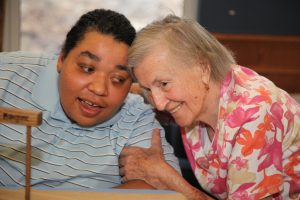“Happy”, the uber cheerful song recorded by Pharrell Williams, was the best-selling song of 2014 in the United States.
 “Clap along if you know what happiness is to you…” I sang along every time I heard it—I still do. I love that song. But deep inside, even as I clapped along I knew I wasn’t all that sure I what happiness was to me.
“Clap along if you know what happiness is to you…” I sang along every time I heard it—I still do. I love that song. But deep inside, even as I clapped along I knew I wasn’t all that sure I what happiness was to me.
Well, kind of, sort of, some of the time (cute kittens), but in the end, not really. The only thing I was sure of is that whenever I finally got what I thought I really wanted, the happiness didn’t last. I knew I was very fortunate—I was alive, I was loved, and I had an amazing life. I knew I should be happy, but somehow it seemed to be one elusive entity.
As a western society we focus on the pursuit of acquisitions—buying material possessions, increasing our status, going on trips—what we want seems to be endless. I have done this and found it results in a continuous ongoing cycle of consumption, but not happiness. Research indicates in fact, that excessive consumption actually contributes to a reduction in happiness and an increase in social isolation and loneliness (Esposito and Perez, 2014).
The loneliness loop
Loneliness is everywhere—over one third of older adults experience it (United States Senate on Aging, 2017). This is especially true in residential care homes such as long-term care (where it affects one out of two), and even in assisted living and retirement.
In our attempts to provide social and emotional care for those in these settings, we are missing a key ingredient—meaningful close relationships.
From an evolutionary perspective, having strong social relationships is a matter of survival, but building and keeping these relationships among humans is a complex process that often fails.
The innate need for social connection serves as a motivator, for to be separated from others is a threat to our survival (Cacioppo & Cacioppo, 2014). This need can also be accompanied by anxiety or fear and create a self-perpetuating loop (Hawkley & Capitanio, 2015).

In a model of loneliness proposed by Hawkley and Cacioppo (2010), the authors argue that for lonely people, this loop consists of a combination of seeing people as threatening, expecting negative social interactions and storing increasingly negative information.
The result is a self-fulfilling prophecy wherein this stored negative information brings about behaviors in the lonely person and in others that confirms the expectations. This perpetuates a cycle of loneliness that reinforces a belief of lonely individuals that they have little control over how they are perceived by others and that they have little social value.
For older adults who face multiple physical and mental health challenges, these complex processes are especially difficult to navigate. Loneliness is not related to the number of acquaintances or contacts we have—it is a longing for closeness.
Ineffective loneliness interventions
Despite the growing evidence that superficial gatherings are not successful at reducing loneliness (Gierveld et.al., 2017), we continue the long-standing tradition of providing light social events.
We do this even though few of these interventions actually reduce loneliness (de Jong Gierveld, Van Tilbur, & Dykstra, 2017). Now we know that loneliness not only makes us emotionally miserable, it also makes us physically sick (Cacioppo and Cacioppo, 2014). Surely, it is time for us to change this tradition.
Residents are telling us what they want. A 2017 study asked people moving in to residential retirement communities what mattered most to them, and they told us (Yeung et.al., 2017). It was a dignified environment that focused on relationship building and reducing loneliness and isolation.
We should pay attention to what residents want and work in partnership with them to make this happen.
The perfect solution
 I end (as I am prone to do), in promoting the power of peer support groups. Peer support is a perfect antidote to loneliness. I have participated in peer support groups and have been active in reaching out to help others connect, heal and find peace.
I end (as I am prone to do), in promoting the power of peer support groups. Peer support is a perfect antidote to loneliness. I have participated in peer support groups and have been active in reaching out to help others connect, heal and find peace.
In the acting of giving to my peers, I have found some contentment and peace in myself and know better now what lasting happiness means for me. And I know I’m not the only one.
Peer support is perfect because studies document it is effective at reducing loneliness and building close meaningful relationships (Keyes et.al., 2014). It is perfect because peer support groups are free, easy to implement and sustain. Us helping one another. Residents helping residents.
The solution to happiness—right in front of us all the time.
Kristine Theurer, MA (Gerontology), MTA
References
Cacioppo, J. T., & Cacioppo, S. (2014). Social relationships and health: The toxic effects of perceived social isolation. Social and Personality Psychology Compass, 8(2). doi:10.1111/spc3.12087
de Jong Gierveld, J., Van Tilburg, T. G., & Dykstra, P. A. (2017). New ways of theorizing and conducting research in the field of loneliness and social isolation. In A. L. Vangelisti & D. Perlman (Eds.), Cambridge Handbook of Personal Relationships (2nd ed., pp. 391-404). Cambridge, NY: Cambridge University Press.
Esposito, L., & Perez, F. M. (2014). The global addiction and human rights: Insatiable consumerism, neoliberalism and harm reduction. Humanity & Society, 38(4), 84-100. doi:10.1163/156914910X487933
Gierveld, J. D. J., Tilburg, T. G. V., & Dykstra, P. A. (2017). New Ways of Theorizing and Conducting Research in the Field of Loneliness and Social Isolation. In A. L. Vangelisti & D.
Perlman (Eds.), Cambridge Handbook of Personal Relationships (2nd ed.). Cambridge, NY: Cambridge University Press.
Keyes, S. E., Clarke, C. L., Wilkinson, H., Alexjuk, E. J., Wilcockson, J., Robinson, L., . . . Cattan, M. (2014). “We’re all thrown in the same boat…”: A qualitative analysis of peer support in dementia care. Dementia, 15(4), 560-577 doi:10.1177/1471301214529575
Hawkley, L. C., & Cacioppo, J. T. (2010). Loneliness matters: A theoretical and empirical review of consequences and mechanisms. Annals of Behavioral Medicine, 40(2), 218-227. doi:10.1007/s12160-010-9210-8
Hawkley, L. C., & Capitanio, J. P. (2015). Perceived social isolation, evolutionary fitness and health outcomes: A lifespan approach. Philosophical Transactions B, 370. doi:0.1098/rstb.2014.01114
United States Senate Special Committee on Aging. (2017, April 27). Aging without community: The consequences of isolation and loneliness (Committee hearing video). Retrieved March 10, 2018 from https://www.aging.senate.gov/hearings/aging-without-community-the-consequences-of-isolation-and-loneliness-
Yeung, P., Good, G., O’Donoghue, K., Spence, S., & Ros, B. (2017). What matters most to people in retirement villages and their transition to residential aged care. Aotearoa New Zeland Social Work, 29(4), 82-96. doi:10.11157/anzswj-vol29iss4id419

hi there. How would I go about starting a peer group.
I have tried it once, but it didn’t really go well.
Any ideas would be helpful
thanks
Hi Louise – thanks for your message. Yes, it’s not easy to structure a successful peer support group. Our first few efforts fell apart too. Eventually, with the input of residents, we developed guidelines, discussion topics, step-by-step guide, music, photography, poetry & quotes, etc. Now the groups have 52 topics to choose from and 142 custom recorded songs.
It is certainly possible to create materials for a peer-support group yourself, but the easiest way is to buy the Java Music Club or Java Memory Care program. Send an email to sales@javagp.com for more information.